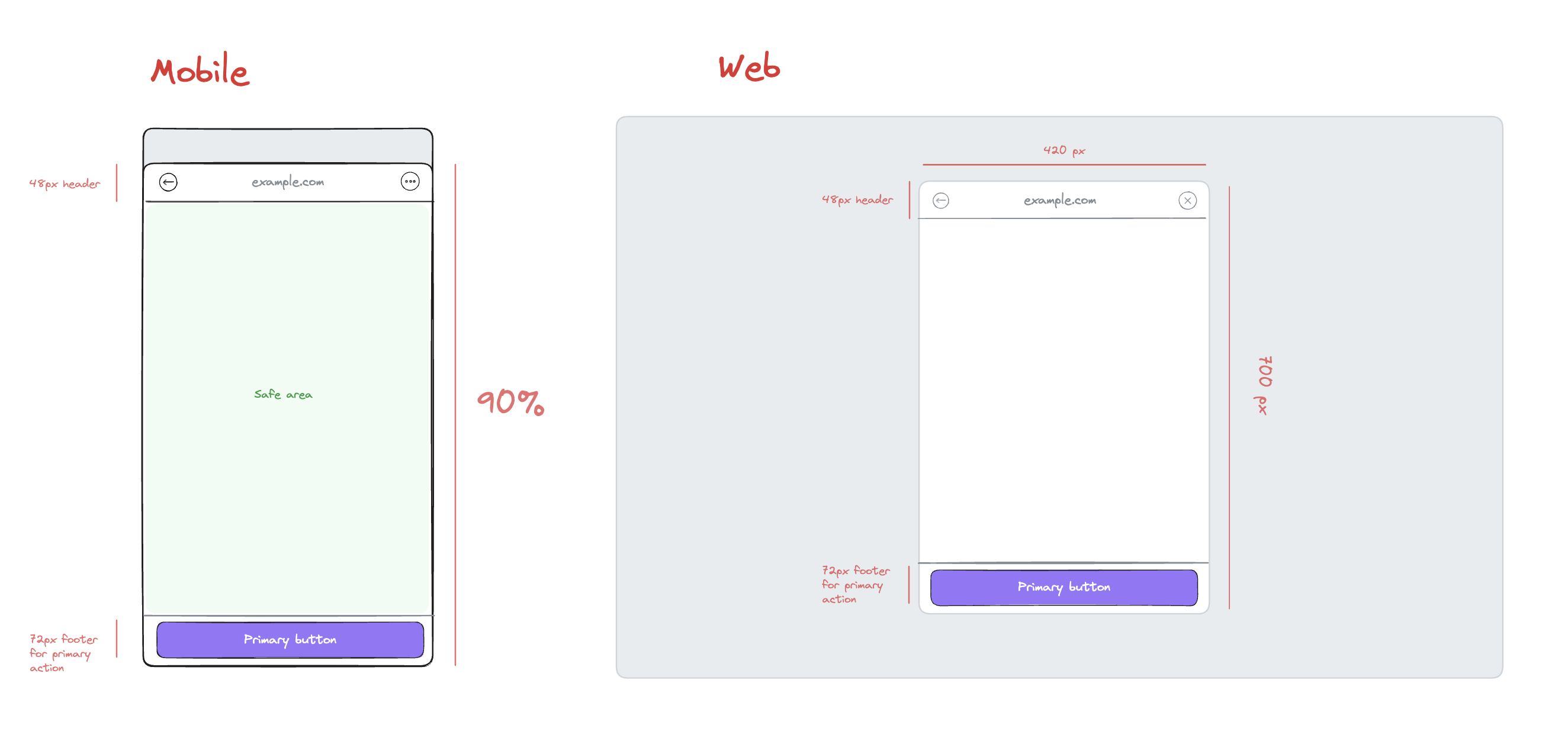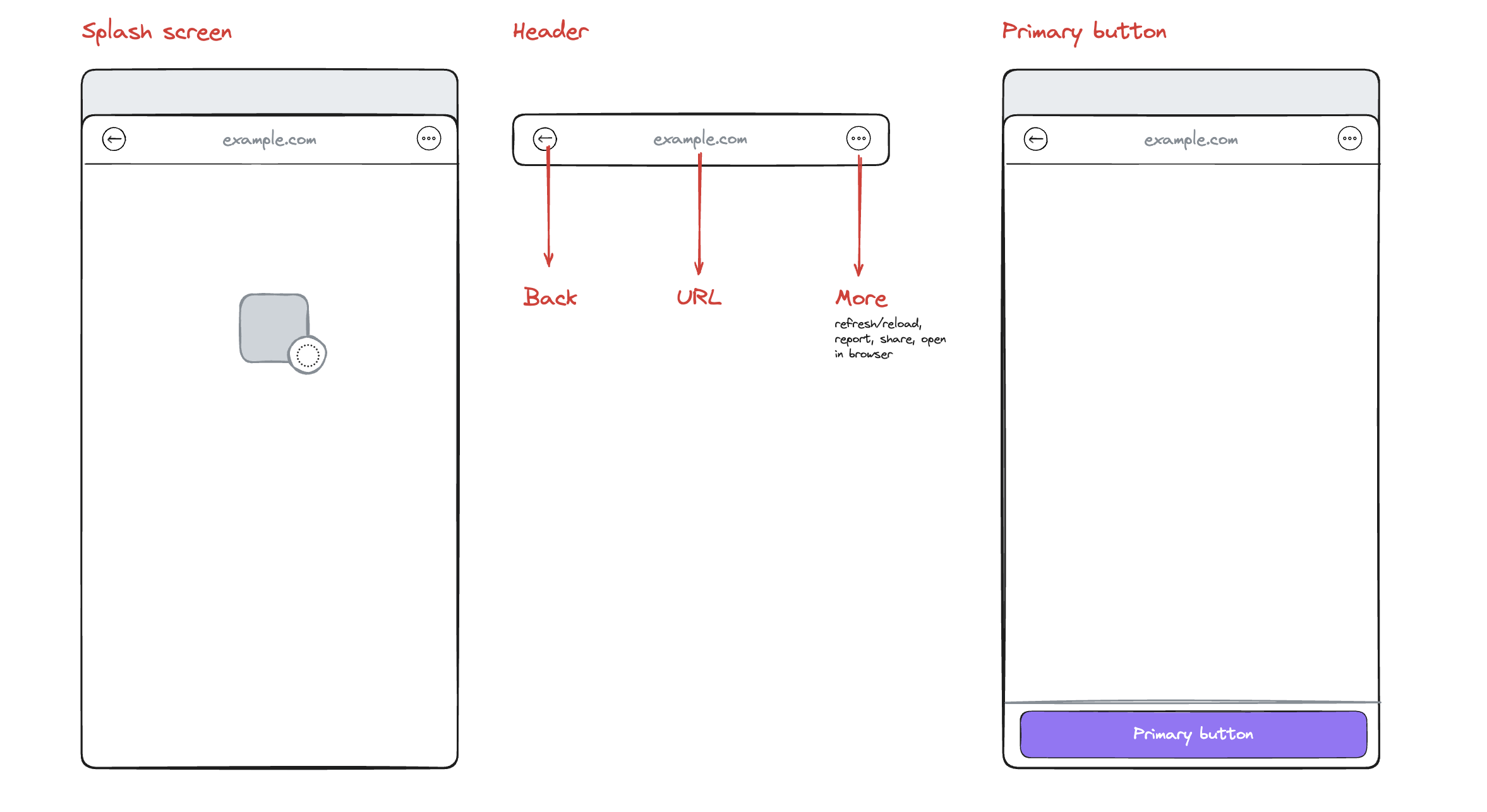An App Frame should be the fastest way to develop and distribute social applications:
- distribute your app in feeds and hooks (i.e. cast action, explore) of any Farcaster client
- use identity to provide social context and allow authenticated actions
- prompt the user to Farcaster actions like sending a cast or joining a channel
- interact with a user’s Ethereum wallet using familiar tools like wagmi
App Frames are the successor to Mini Apps with the following key changes:
- better performance — App Frames are opened directly without requiring a POST first
- expanded API — expanded functionality, built-in UI elements, and wallet exposed via an Ethereum Provider
- permissionless — no more allowlisting of domains for use in Warpcast

Spec [Draft]
Unreleased
This is a Work-in-Progress and subject to change. Please provide your feedback by direct casting @deodad or posting in /fc-devs and tagging @deodad.
User Interface
An App Frame should be rendered in a vertically oriented modal element.


Header
A Header must be rendered above the App Frame that displays the domain of the App Frame being viewed and a back / close button.
Splash Screen
A Splash Screen must be immediately shown when a user launches an App Frame using the image and background color specified by the App Frame developer. The App Frame can hide the Splash Screen once it is loaded and initialized.
Primary Button
An App Frame will be able to programmatically set and update a Primary Button that will be presented to the user in the footer below the App Frame. An App Frame can use this button to create a clear and consistent call-to-action for the user.
Launching an App Frame
An configuration object defines how to launch an App Frame.
type AppFrameConfig = {
/** URL that hosts the App Frame */
url: string;
/** Image to show on the Splash Screen */
splashImageUrl: string;
/** Background color to show on the Splash Screen */
splashBackgroundColor: string;
};To launch an App Frame, url is opened in an embedded web view. A Splash Screen is rendered with splashBackgroundColor as the background color and splashImageUrl as a background image. The App Frame will call hideSplashScreen once it is ready to be presented to a user.
API
App Frames would have the following API provided by the Farcaster client hosting the App Frame.
untrustedUser
Information about the interacting user.
type UntrustedUser = {
fid: number;
username?: string;
displayName?: string;
pfpUrl?: string;
};This data can be used to customize the interface, however, you should not trust this data for taking privileged actions as this user. Instead, use the requestAuthToken endpoint to get an authenticated token that can be verified by your backend.
launchContext
Context on how the AppFrame was launched.
type CastFrameEmbedLaunchContext = {
type: 'cast_frame_embed';
castHash: string;
};
type DirectCastFrameEmbedLaunchContext = {
type: 'direct_cast_frame_embed';
};
type CastActionLaunchContext = {
type: 'cast_action';
castHash: string;
};
type ComposerActionLaunchContext = {
type: 'composer_action';
cast: {
parent?: string; // Cast parent hash
text?: string; // Cast text, can include @mentions
embeds?: string[]; // Embed URLs
};
};
type ChannelProfileLaunchContext = {
type: 'channel_profile';
channelKey: string;
};
type LaunchContext =
| CastFrameEmbedLaunchContext
| DirectCastFrameEmbedLaunchContext
| CastActionLaunchContext
| ComposerActionLaunchContext
| ChannelProfileLaunchContext;setPrimaryButton
Set the Primary Button.
type SetPrimaryButton = (
options: {
text: string;
enabled?: boolean;
hidden?: boolean;
},
callback: () => Promise<void>;
) => Promise<void>;close
Closes the App Frame and optionally show a toast.
type Close = (options: {
toast?: {
message: string;
};
}) => Promise<void>;hideSplashScreen
Hides the Splash Screen. This should be called after the App Frame is initialized and ready to be presented to the user.
type HideSplashScreen: () => Promise<void>;ethereumProvider
An EIP-1193 Ethereum Provider for interacting with the user’s connected wallet. App Frames can interact with this provider using familiar tools like wagmi to:
- get the user’s connected Ethereum address
- request a transaction or signature
- and anything else supported by Ethereum RPC
requestAuthToken
Request a JSON Farcaster Token that can be used to make authenticated requests to server.
type RequestAuthToken = (
options: Partial<{
/**
* When this token should be considered invalid.
* @default 15 minutes from now
*/
exp?: number;
}>
) => string;See the JSON Farcaster Token for full details.
Note on authentication
The token is signed by an App Key—this means any application the user has granted a key to via the Connect to Farcaster flow can make authenticated requests on the user’s behalf.
For many applications this is sufficient, but note that this is different and weaker than Sign In with Farcaster; a second form of authentication should be used before giving acess to sensitive information or a significant funds.
openExternalUrl
Opens a URL in a web browser.
type OpenExternalUrl = (options: { url: string }) => Promise<void>;openFarcasterUri
Close the App Frame and navigate to a Farcaster resource (i.e. cast, profile, channel)/
type OpenExternalUrl = (options: { url: string }) => Promise<void>;openCastComposer
Closes the App Frame and opens the cast composer.
type OpenCastComposer = (
options: {
text?: string;
embeds?: string[];
channelKey? string;
parentCastHash?: string;
}
) => Promise<void>;followChannel
Prompt the user to follow a channel:
type FollowChannel = (options: { channelKey: string }) => Promise<void>;FAQs
When can I start building an App Frame?
We are shooting to have an SDK and playground that developers can use to start building their App Frames by the end of next week (November 15th).